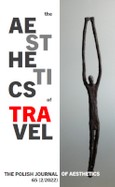Paradoxical Monotony
Paradoxical Monotony
Author(s): Raivis Bičevskis:Subject(s): Music, Aesthetics, Early Modern Philosophy
Published by: Wydawnictwo Uniwersytetu Jagiellońskiego
Keywords: J. G. Hamann; Tonality; Nature; Senses; Song;
Summary/Abstract: If we look at the impressions and influences of Johann Georg Hamann, an Enlightenment-era thinker, in the context of Livonia and Courland from the aspect of producing text and thought, then J. Ch. Berens’ project of an enlightened commercial republic in Riga appears as its first episode and as a far-reaching thought complex. Hamann’s studies have a philosophical-cameralistic character. They provided a broad modern vision in fragments. The thought complex, where recourse to Latvian folk songs and their meter and tonality appears in the “Aesthetica in nuce” (1762), also rests on this ground. The passage at the end of “Aesthetica” is once instrumentalized in identity politics, solidified, and mythologized even within the framework of Latvian national culture. However, the text passage is extraordinarily complex and interwoven with several layers of context in Hamann’s contemporary environment. One of the critical concepts in this passage is “monotony.” This concept needs to be addressed in more detail, as it does not universalize and unify but individualizes and divides. Hamann’s monotony is paradoxical: the unity of the world is linked to the diversity of the world’s sounds and colors, languages, and times: the world itself is a paradoxical monotony. With recourse to “Socratic Memorabilia” and various passages from “Aesthetica in nuce,” this paper shows that this folk poetry passage becomes more understandable only when considering the background of Hamann’s main ideas. Since singing and possible poetry can be found in Hamann, a Hamannian series of thoughts “God-Nature-Language-Senses-Poet” is turned and solidified national-culturally with the help of Herderian motifs. There is no such consolidation in Hamann. Indeed, his theological-eschatological philology of listening and tonality of nature at the end of the “Aesthetica” contains a prefiguration taken up and continued on this side of Hamann’s statements in modernity.
Journal: Estetyka i Krytyka
- Issue Year: 64/2022
- Issue No: 1
- Page Range: 151-159
- Page Count: 10
- Language: English

